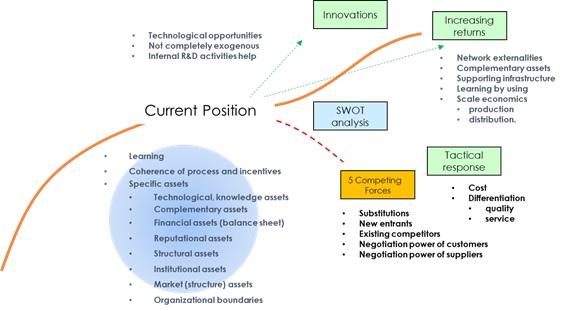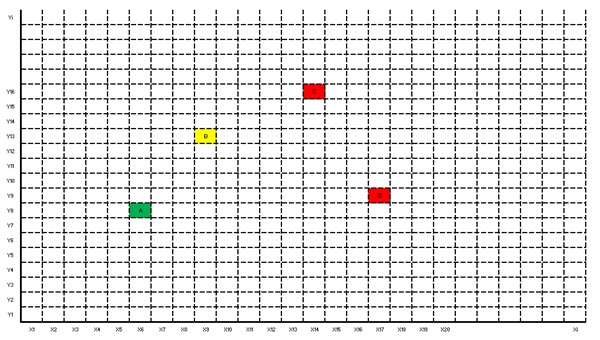 |
|
||||||||||||||||||||||||||||||||||||||||||||||||||||||||||||||||||||||||||||||

|
 Notes of JFU CPA, Tax Advisors, and Digital Tools are prepared for sharing our thoughts on problems encountered in the course of our practice. Subscription is free. Questions and comments are welcome; feel free to write to the Editor, JFU Notes, enquiries@jfuconsultants.com We will soon open our cloud-based risk management system. Companies that wish to build a formal enterprise risk management system are eligible for a free trial. If interested, you may register your intention to participate at JFU ONLINE REGISTRATION WEB PAGE. Space is limited. Charting Growth
Source : JFU | Digital Tools
20 September 2021
We can consider a start-up as having attained its initial success when:
The firm must now contemplate a path to move forward and grow before its initial success begins to dwindle. Charting a path to the future always begins with the present. Exhibit B below is an extension of Exhibit A in our last note.
Strengths, Weaknesses, Opportunities and Threats— Know Thyself and Thy Risks A SWOT1 analysis can be used to locate a firm’s present position in terms of capabilities and risks. It is a relatively simple tool that requires a methodical and thoughtful application to deliver fruitful results. The result of a SWOT analysis is usually presented as a two-dimensional matrix of four quadrants, one for each aspect of the firm in its present state. For charting growth, we suggest a slight modification to the two-dimensional four quadrants matrix— conceptualizing it instead as a two-dimensional continuum for locating strengths and weaknesses (capabilities), as well as opportunities and threats (risks). Exhibit C is an illustration of the two-dimensional continuum. On the principal axes, {X1, X2…Xi} denotes capabilities available to a firm. {Y1, Y2…Yi} denotes the risks it is facing. {A, B, C, D} are, respectively, available actions or strategies that a firm considers as the best match between capabilities it possesses and risks it is facing. Colours can be used in this type of illustration to indicate priority, importance, technical complexity, and more. For example, point A at (X6, Y8) means that A is the strategy (or group of actions) that a firm with capability X6 can apply to deal with opportunities or threats at Y8. Used in this way, the two-dimensional continuum grid works like a map that hikers use for charting preferred trails in the mountains.
The Present Position In finding the present position on this two-dimensional continuum, history matters. A firm’s present is a function of its past. Its present position comprises not only financial assets or liabilities on its balance sheet but also capabilities and non-financial assets formed over its entire business history. Such assets and capabilities cannot be bought externally, as they are built internally within a culture of learned and internalized experiences. Hence, firm-specific assets—formed from a company's inception to the present— dictate where a firm can go in the future. This is why the growth path of every firm is unique, and firms cannot find long-term success by simply mimicking other firms. When locating firm-specific assets, start the exploration at:
Together they form the strengths of a firm and reveal a firm's weaknesses. These factors are the basis of a firm’s dynamic capabilities, which can be deployed in response to threats and opportunities.
The Future Position: Paths Available Broadly speaking, four paths exist in a firm's future. The path downward. A firm is an ordered system subject to chaos that constantly arises from both known and unknown sources. All firms are therefore prone to fail in the absence of deliberate efforts to keep it growing. One example of known sources of chaos is shown in Exhibit B, which shows a model of 5-competing-forces. Substitutions, existing competition, new players, change in negotiation powers of the customers and change in negotiation powers of suppliers are all major factors. Other unknown impacts can unfavourably affect supply and demand curves or production schedules. Examples include changes in consumer tastes, fiscal and monetary conditions, short-term geopolitical developments or longer-term demographic shifts. All these factors can drag down a firm, if not observed and monitored. If a firm depends solely on its current structures for success and continues business-as-usual, its path will likely lead to downward trends. Demise becomes just a matter of time. The path of innovation. Innovation provides constructive disruption to a firm. Innovation can take the form of organizational or technological changes. One old but powerful example is the limited liability company. It was an organizational innovation in the 19th century that reshaped production by scaling up industries and raising productivity, ultimately benefiting firms and economies in a big way. Technological changes give rise to new business models that can sometimes force old giants to become marginal players. The path of innovation is not exclusive to those companies which spend heavily on research and development. Commercial applications are widely available to those who are open to innovation and those with an imaginative eye. Innovation is a steep upward path that requires a lot of determination and preparation. The path of increasing returns. A firm can be viewed as a complex production system converting inputs into outputs, the values of which are realized at the point of exchange. One can usually identify many valuable improvement opportunities by carefully examining each key element in the production system — especially those elements affecting exchange. A few examples are shown in Exhibit B, such as the formation of collaboration to capitalize on network externalities and expanding organizational or operational boundaries. The path of increasing returns allows a firm to grow in terms of scale and efficiency. It is a safe path but requires methodical study, meticulous attention, and disciplined management. The path of tactical responses. This is a defensive path of actions that can be instituted in response to drags and pulls a firm is experiencing, such as cutting costs or offering improvement on product differentiation with better pricing, design and functionality. It does not give a firm a very well-sustained uplift in prospects, but does buy more time to seek a better path and implement a longer term strategy for survival.
Employing Dynamic Capabilities to Chart Growth Knowing these broad paths is the first step. Once aware of the broad possibilities, a firm has to chart its unique course. You may recall that applying dynamic capabilities requires a two-dimensional continuum or a grid to locate firm-specific capabilities and risks (Exhibit C). A firm can choose its path by matching available capabilities to risks it is facing. We shall discuss this strategic process in our next note, and share ideas on how risks can be known. Exhibit B
Exhibit C
1 Strengths, Weaknesses, Threats and Opportunities |
 Please contact us
for more information Tel: +(852) 3719 6000
|












